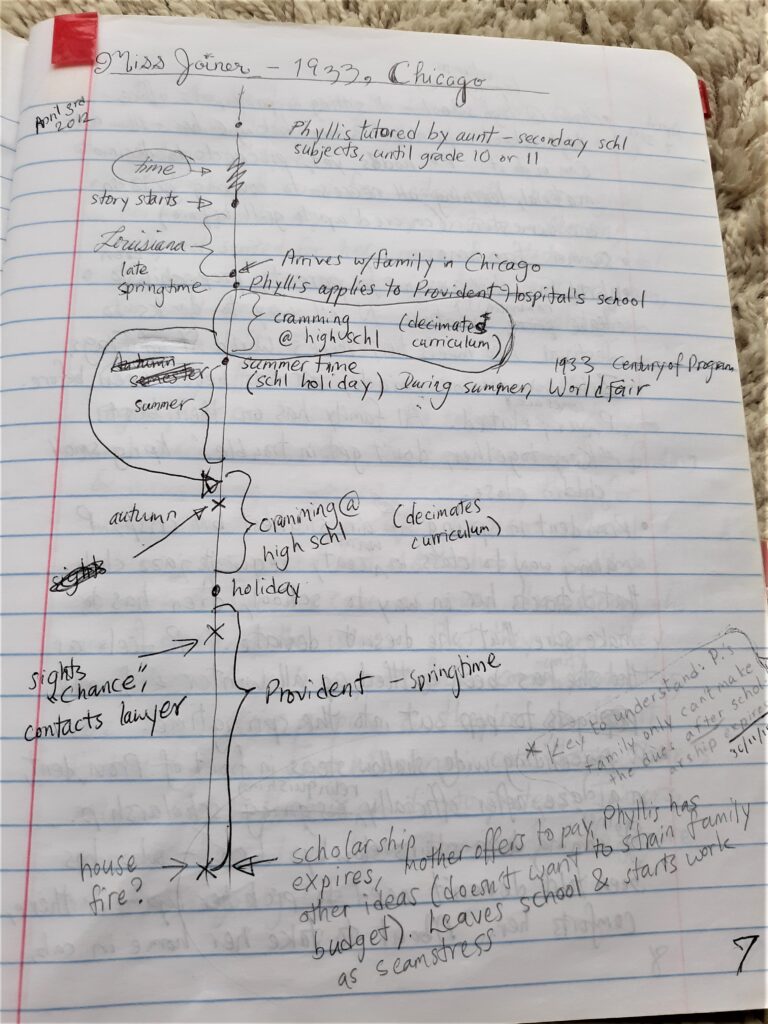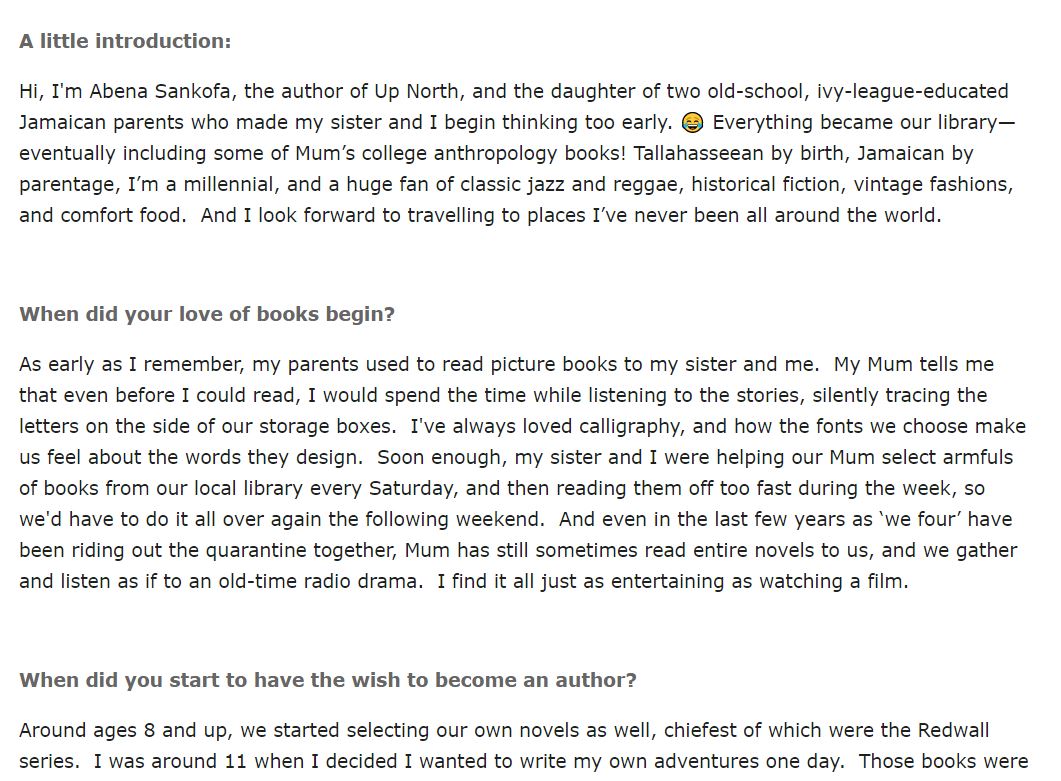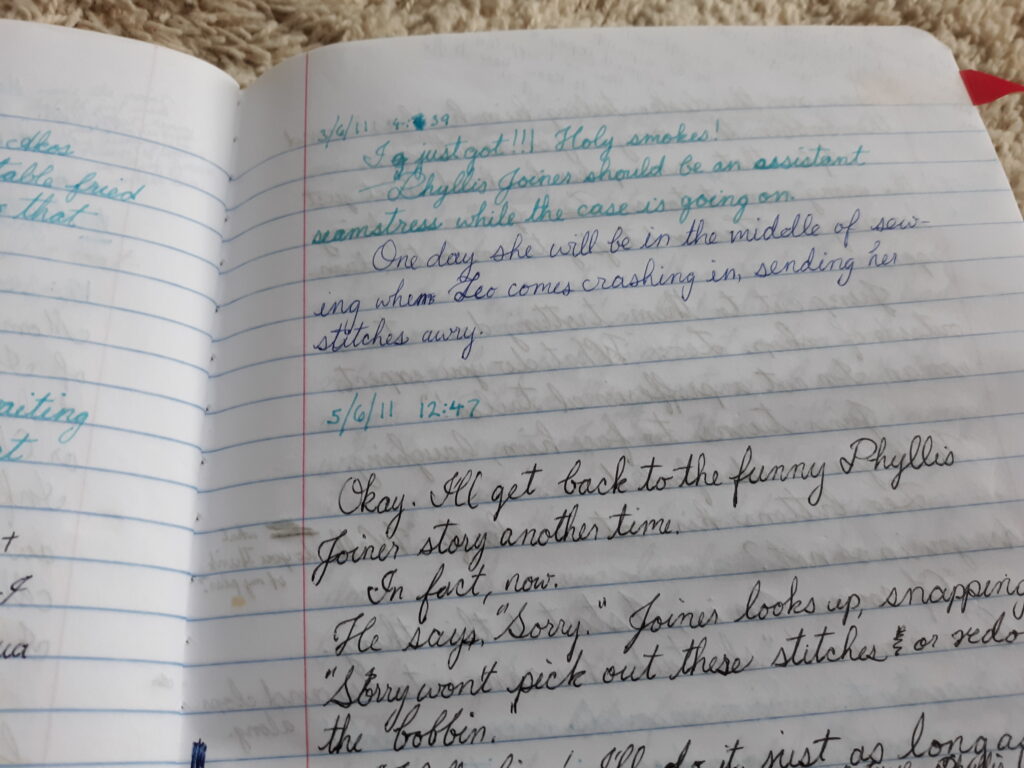
Abena Sankofa
Posts by Abena Sankofa:

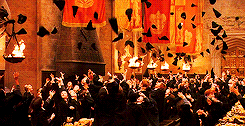
My Official H.I.G.M.A. Post, “How I Got my Agent”, or rather, “How I got my Offers”!:
OK folks, I’m so happy to finally make my official contribution to the great HIGMA (How I Got My Agent) blogging trend!
This is all about how I got my offers, and what I did next — even though I didn’t end up choosing a literary agent.
“Wait, WHAT?” I can hear you say, “After all that querying?”
Yes — but let me explain:
So, let’s set the scene: It’s the afternoon of April 6th, I’m about to enter #MoodPit (A Twitter novel-pitching competition in which you can actually post a visual collage for your story), and, after days of frantic prep, buying stock photos, and editing them, I’m almost ready to go!
On a break, I decide to check my email. It’s kind of a laugh, really, because, like, we all know an agent hasn’t written.
Except one has:

[Etc… the letter continued]
Well, for context, this is the query letter that scored the offer!:
Dear XXXXXXX,
I’m writing to seek representation for my Jazz-Era mystery, Up North.
The year is 1933: After her family is driven from their Louisiana home by ruthless bounty hunters, teenage Phyllis Joiner tries to start afresh as a cabaret singer in Chicago’s most notable Jazz district….only to realize she has been followed. For no amount of “fitting in” can disguise her from the men who know her on sight: her family’s nemesis Smith Owens, his two sons, and shadowy right-hand man have trailed them.
As her mentor warns: “This town ain’t no picnic. There’s danger around every corner for a runaway like you, if you let your guard down.”
Soon, Phyllis discovers the real reason for their relentless pursuit—a secret Joiner family treasure worth millions. And not having it with them when he comes will be no protection.
Caught in their tightening net, she decides to turn the tables on her stalkers, tracking down their hideaway in a reckless gambit her newfound policeman beau terms, “Mouse chases Cat.”
However, Phyllis soon finds herself holding a tiger by the tail—for Smith Owens has allied himself with the most powerful syndicate in Chicago….And time is running out before they reach her family.
But to avert disaster, she must seek the help of a Hyde Park lawyer who is none other than the nephew of the man hunting her down.
I was honored for my novel to receive Chanticleer Book Reviewers’ prestigious 5 out of 5 star-rating and review, as seen here: https://t.co/WyC04K8H66
This book will most likely appeal to young female readers who love a good mystery, with a devil-may-care heroine at the lead. Set in the swinging Jazz Era, this should pull in fans of gangster-themed shows like Boardwalk Empire, or of timeless African-American period dramas like The Piano Lesson.
Comparable titles in this genre: Diane McKinney-Whetstone’s “Tumbling,” Joyce Licorish’s “The Forbidden Ring,” and Kara Lee Corthron’s “Daughters of Jubilation.”
This gritty narrative is, as Chanticleer Book Reviewers noted, “nail-biting”, at times—it’s a true emotional rollercoaster. And yet, the rollicking tone, Phyllis’ peppery sense of humor, and a budding romantic comedy-of-errors leave room for a good few laughs along the way!
Thanks for your time and consideration. I look forward to hearing from you.
Sincerely,
Abena Sankofa
An Offer.
I’m stunned. And slightly beginning to panic — I’d already entered #MoodPit. This was the lit agent that I’d done the least research on, and I didn’t know how likely her editorial advice would suit my book. Would I have to bow out of #MoodPit (and the chance to have more options) if I acknowledged this offer? I asked both the organizers and the offering agent, to be totally sure, and both suggested I stay in. 😅 Thank goodness for a super-gracious agent!
She was this generous especially because of one detail: She would not be able to begin pitching for me for the near future, as her schedule remained full for a time. So, I was quite within my rights to continue with the pitching contest, and try to find another agent who could work with me more immediately, if I wanted.
I did, and even scored an agent like! 💚
So, after the event, once I scheduled the Call with the agent in question, I went onto what I assumed would be the most TERRIFIC part of the querying process — finally getting to tell all the other agents I’d had my first offer (including the one from #Moodpitch).
Like this:
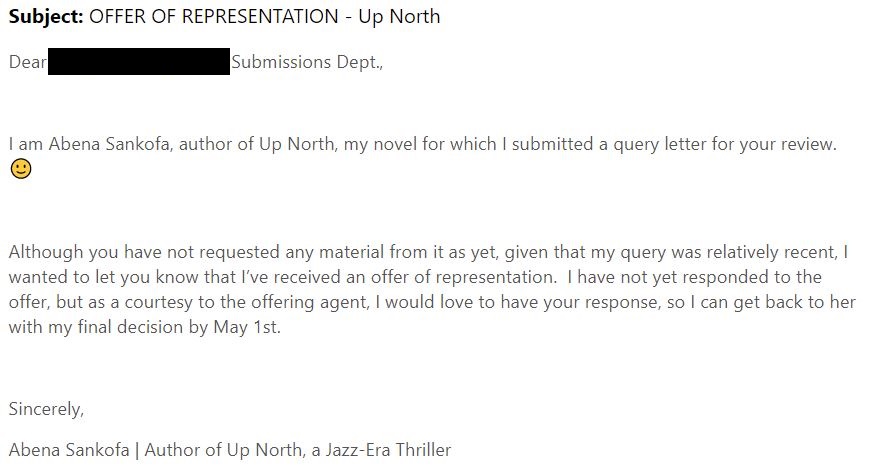
But really, it felt saying like this:
I gave them two weeks, which was the longest amount of time I’d ever read that agents would need to read their fulls.
I was a little nervous, as I thought, I may be narrowing down my options too soon, if some agents bowed out for lack of time to read. But, on the other hand, I had about a dozen queries out. If the writers’ blog advice I’d been reading panned out, at least two-thirds of them should get back to me, and among those, maybe I’d get …3… offers? 🥺🤞🏽
Over the next few weeks, the grim reality hit. No, agents don’t necessarily swarm in competitively, to claim a chance to read (even a contest-winning) manuscript, and see what the buzz is about. 2 got back to me to politely pass on the manuscript, 1 more offer came in (YAY!), but 6 did not even respond.
The hard truth was, I still haven’t gotten a response from most of them. Right then, it was beginning to seem to me like they just didn’t care. 🥺😥.
Or, more soberly put: The hard truth that is that most literary agents have hundreds of queries coming into their inbox everyday — one agent who posted her query stats on Twitter said that, although she was participating in a Twitter pitch event, she already had 900 in her inbox. I can’t imagine what sorting through all those must be like. My private opinion? It’s got to all blur together after a while.
Which leads me to my next point: I was picked up by a very new agent, who probably had not been subjected to that deluge. My point is, in nutshell: For frustrated, querying authors, who say, might be sorting through Jericho Writer’s Agent Match (although that is not how I found my agent), we might find better success working with agents who are, as the British-based writing mentorship org’s categorization terms it, “keen to list-build“.
This means these agents are wanting to build their client list, and aren’t too overwhelmed to ignore your manuscript just because it doesn’t track with the current market trends.
Hallelujah! (An important note to querying authors, however: AgentMatch does not frequently update listings, so it’s important to Google every agent before you query, in case they are no longer accepting submissions, or have been let go from their agencies, and WHY.)
…But I’m skipping something: one other place I’d queried did reply almost immediately when I sent out my nudge-letters saying I’d gotten an offer, an offer in response to this query I’d sent approx. 2 weeks before:
MY 2nd ACCEPTED QUERY [linked]
A small publisher got back to me THE VERY NEXT DAY, seemed intrigued by my original storyline, but had some editorial suggestions to put forth, if I wanted to schedule a call.
I, at the time, was 90% set on an agent, and so I wasn’t sure whether to go ahead with it.
[Partially because the internet had recently scared me with this gem: Unagented authors about to enter into an agreement with a publisher should not do the contract-analysis themselves; they’ll need to pay an expert. 🤯💲😵😖😭!
But more on how I handled this phase in my next Post, all about publishing contracts. Stay tuned]
But, I got an inkling to schedule the talk anyway — why close myself off from a good perspective on my work’s chances in the market, as well as find out more about how publishers actually conduct business?
So I scheduled it to coincide with when all the other agents would hopefully get back to me, as I set a new deadline.
Speaking of which, let’s talk *NUDGE DEADLINES*. Every single writer’s blog I read up ’til then, said, once you’ve got an offer, it’s impolite and unorthodox to keep the offering agent waiting for more than 2 weeks. Sometimes even one week to field responses from other agents is enough.
Only thing, by sheer luck, I had more leeway: the offering agent was scheduled out for a number of weeks, so I had more than 2 weeks to give the other agents to look over it.
I should have run with it.
I didn’t.
I said to myself, “There’s going to think this is just odd that they’re being given so much time, they may even doubt I’ve had a real agent offer, so I’ll stick to 2 weeks.”
It was mid-April, so I happily sent out nudge letters saying, if they could get back to me by May 1st, that would be terrific.
Expectation: The agents would respond quickly, to either offer or decline, because they would be gauging the time they’d need to read the manuscript.
Reality: 😳
…
The call I’d scheduled with the offering agent was in late April, so there was arguably two more weeks I could give them, ending on May 9th.
So, just before the call, I wrote and sent out a second wave of nudges, letting them know there was a little more time, and offering them my agent’s contact info in case they wanted validation. (In the ensuing weeks, all of 4 more got back to me to politely pass on the manuscript, so this added time did, indeed, help.)
And so now, to “the Call”:
So I was all tense, right? This was the first time in a looong while (since Up North’s quarterfinalist placement in Coverfly’s Cinematic Book Competition, or Chanticleer Reviewer’s 5-star rating and review), that I would be getting feedback on my *entire* novel.
What editorial advice would a literary agent have?
It was a really great interview: She immediately made me feel at ease, and in answer to that first question — she actually hadn’t finished the book! Lit agents have to read and draw conclusions fairly fast oftentimes, but from what she had read, my prose had a really good flow, with “punchy dialogue” that she did not often see in debut author’s work.
I was thrilled! 😊
And no, she didn’t have any editorial advice, nothing to cut, nothing to replace. And to be honest, as a debut author, I found that the fact that she was now to her field as well, only made her more relatable.
But, for later on in the process, she made it clear that when it came to contracts and such, other experts might have to be brought in, because that was not one of her areas of expertise.
I left the call feeling like that could possibly be handled.
The very next day, the call with the publisher was scheduled.
I went in, very prepared to ward off all major editorial suggestions surrounding cutting or replacing.
Having honed the same story over 10, going 11 years, I just couldn’t imagine what those could be.
The call began like this: First of all, I got to speak to an editor at Winding Road Stories, and was asked what was the vision for my book. It was such an important question, and the conversation that developed from there was about how to further that vision.
For one, I was internally cringing to hear about any recommended changes (coming off the previous call which had left me confident there didn’t need to be any). But when I heard them, they blew my expectations out of the water!
-
First off what was great: the things he loved about the saga (the strong heroine MC, dialogue that hit all the notes for the time period) were the things that I loved about it – and what’s more, everything his company was looking for in terms of historical fiction, 100% aligned with the kind of things I like to watch & write. That was *huge*.
-
For the second thing, in terms of the editorial side, he was highlighting things I’d already always had vague dissatisfaction/doubts about – for one, when exactly should I reveal the antagonist’s back-story?
I had done well enough to get good reviews on the book, but had been left with a lingering feeling that I still wanted feedback on how the flow of the book would go over with audiences. But without even asking, now I had it: and I felt the suggestions offered would indeed make it better! 😃
I was totally confident in the honing and delivery of my characters and their dialogue, the kind of “coming-of-age” arc of the novel, but tbh, mysteries have always been pretty opaque to me – how are they built from the inside out? To do both had been a challenge I’d accepted a long time back. And I had taken that about as far as I could outside of mentorship.
The advice he gave surrounded strategically dotting more clues throughout (to say more would be full of spoilers, but it definitely clicked for me)!
UPSHOT: Just when I thought I knew what to expect, my expectations were blown out of the water — the first call left me feeling like, if I had to choose, rapport with the person guiding me through to publishing would outweigh the experience factor.
The second call left me overcome with excitement that I didn’t have to to choose — you can have BOTH on your side!
My mind was pretty much made up after the call, but I gave myself time (2 weeks of time!) to field any remaining agent-replies while reflecting, reviewing, and comparing all sides of both options.
*But there is the matter of the marketing engine — larger publishers always seem to have the advantage on that one. Why not allow a literary agent to take my manuscript “on submission” (pitching my books to multiple publishers), and try could score an acceptance by one of the Big 5?
This was the ultimate tie-breaker: If I went “on submission”, there was every chance in 100 that my book would eventually end up being accepted by a publisher whose editor whose vision didn’t align with mine, and would force my story into the mold of whatever was trending. This can happen all too easily, as seen in the experience of author Sarah Ainslee, which she so honestly shares on her blog, SarahAinslee.com. That had been the reason I’d initially even consider self-publishing, but broke off that line of research due to the staggering up-front costs. The opportunity to have my book’s style and substance preserved by an editor who “got it”, in a company that didn’t charge authors up-front (like the dreaded vanity publishers), was a piece of rare luck.
Whereas, if I went “on submission” (pitching my books to multiple publishers), there was every chance in 100 that my book would eventually end up being accepted by a publisher whose editor didn’t have as aligned a vision for my book as the one I’d already interviewed.
Why take that risk?
By now, you probably guessed I chose Winding Roads, and you’d be right! 😊
But how would I tackle the contract-deciphering part myself?
Well, I should say, first of all, that the company was very much open to answering all my questions, and gave me ample time to research what those would be — no added pressure.
But how did I find out what questions to ask? Everything about that in the next post:
“My First Publishing Contract” >>
As always,
— Love, Abena.

To Snowflake or Not to Snowflake?
What is the Snowflake method, and did it work for me?
Well, before I get into it, a brief disclaimer: the man behind the Snowflake method, best-selling author Randy Ingermanson, is an authority on the subject — so I the article below is not a critique, it’s purely an exercise in figuring out:
A) is your writing style is like mine, and
B) if it is, would the Snowflake Method layer well on top of that?
So, here goes:
So, when I heard of The Snowflake Method the first time, from a friend of family, my sister and I immediately ran to the P.C. to look up what that was:
And here, you can read the official description at advancedfictionwriting.com.
But here is my paraphrase: You start with a sentence, a kind of a movie-logline, of what makes this story special. (I came up with mine waaay after the story’s beginnings in 2011, just last year, 2021):
“A teenage songstress-turned sleuth matches wits with the most dangerous syndicate in Chicago in a race to find an inheritance worth millions.”
Pretty fair, right?
The only problem was (for me, that is): I came up with that one line last year, after *ten* years spent shaping the story, meditating on its structure, and then switching to my marketing phase: figuring out what about it would most appeal to the market, not necessarily myself.
Because, you see, what catches your fancy about your story might not be *necessarily* what eventually interests the publishing world.
With my long-held interest in the history of the Underground Railroad, what I found most interesting about my own tale at the time, was the escape from their initial home, and their edge-of-your seat escape Northward, and gradually putting down roots, and learning the ways of the jazzy, swanky North with its bright lights and opportunity. It was the slow build that interested me, the cultural sweep of Phyllis’ coming-of-age story. And I needed to sit with that, expand on it, and only ten years later did it slowly dawn on me that it was the city slicksters and the crime ring that would probably mostly catch the everyone else’s attention.
So, what I’m saying is, don’t beat yourself up if your initial logline is more of a wispy half-paragraph, and when read aloud, it doesn’t sound like a film trailer: I feel the logline method suits an experienced writer, who’s been in the world of fiction for a while, and has honed an instinctive understanding of their audience. You (me, really), at the beginning of our long adventure, need not pin down what everyone else is looking for yet—or even what we’re looking for. We need some space and time to gather our thoughts, and realize why we’re interested in this.
But back to the Snowflake method. Expand your logline (if you have one) to a paragraph.
Next, add your character’s name (again, my intuitive, zany, out-of-sequence style balks at this, for my character names only come to me when I’m not thinking too hard).
And by Step five, you’ve written a page on each character, their back-story, their aims, their foibles, the lot.
But really, in my experience, I only came up with Smith Owens’ (my top antagonist’s) aims, somewhat later in the process, after I thought of the climax of Book 1.
Suppose the thing he was *really* after was less of a person and more of a thing? Suppose the long chase, and it’s continuance into the sequel, was because he was after treasure? One rumoured to be in my main character’s family-line, and therefore, a treasure he — wrongly — believes he owns?
And then, I finally had my Antagonist’s back-story.
You see, this style I have (if you can call it that 🤨😆), is a little like Billy in the comic “Family Circle” — it’s a three-yard walk from his front door to the mailbox. But he’d take the scenic route, walking all round the yard, looking at beetles and interesting things until he remembered what he was actually there to do, and found his way to mailbox.
Similarly, when I’m unsure what to write, I meander, perusing through all the most sentimental scenes I’d most like to see on the big screen. and Oh! up pops a plot solution I hadn’t thought of before. I find this style so much more organic, and seems to let through the einsfall (a real word for sudden inspiration!) that we’re all looking for.
So, in a nut shell, I would say, don’t strain to summarise your story too soon — that would be like trying to estimate the final, adult height of a child right after it’s born. Give it a chance.
BUT THEN, PLEASE USE THE SNOWFLAKE METHOD.
What do I mean? Well, here’s what I did:
I attempted to catch hold of, and put on paper, the “soul” of the story, the bite-size flashes of insight from all around the story, and built outward from each one, until they touched and merged, like this:
If you were to look into my notebook right now, you would see amply blocks of text, excerpted from later stretches of the saga, random places in the timeline of my story that just happened to come clearly to mind just then. This is very important, I wrote them in the order that they came to me easily. Trying to link them up and write them in sequential order when you feeling out-of-sorts leads to grey, un-feelinged prose, at best, strained re-hashing of tropes one has seen elsewhere, at worst.
I have to pause to give credit where credit is due, however: I’d never have gotten these down without the help of my sister. I was so timid and hopelessly judgmental of my own handwriting, of things, that I would never have gotten down this amount in such time. I rather, walked around, and she took dictation. You could get this effect with text-to-speech, and then freely speak right from your imagination “…And then, X would say this, and Y character would be taken aback, but not respond just then…and then later, it’d be too late…” something like that. UN-polished, raw thought-matter.
Eventually, I snapped these into order—again, with Big Sister’s help (Thx, Akos!) and—voila! I had a story-timeline:
There, I could clearly which parts where done, as if a clay sculpture, to be made from clay patted onto a wire form, I could see which parts of the wire-form were still empty.
I began writing in Word files, copying the journal-notes (that I just spoke about in post-before-last, “How to make a Scene come Alive”!) onto Word documents, and there, finally, the process naturally coaxed me to keep adding more. Always referring back to my written time-line, I knew what direction to each scene things in.
And there it happened. Up North.
No matter how finished you feel at the end of this, the next step is absolutely to edit it yourself, (take out all the parts where you couldn’t decide which way to write a given scene, the places where you inevitably find yourself stuck no matter how long you look at it. For that, I have two possible solutions, as seen in my next planned Blog Post “Can There Be Too Much Editing?” which I’m thinking of re-naming: “Gosh, Now I’m in a Fine Pickle”:
But here’s a tantalizing teaser: Tip #1: Write it both ways—don’t choose, not just yet.
And Tip #2: Mime it out –Do Acting Exercises. (Yes, you read that right.)
And as Johnny Carson’s famous go-to-break montage used to say, “More to Come….”
—Love, Abena

I got to write a special guest blog! ?
Guess what?
I’m so happy to announce:
I’ve been hosted by the gracious blogger, Fraser of @feed_my_reads on Twitter, on his author blog, seen here:
>> Feed My Reads interviews author Abena Sankofa on her novel, Up North <<
(Also, preview image below can be clicked to view article):

How to make Scenes *Really* Come Alive
So, your idea starts out as an unsolicited thought of a premise that’s fun for you to imagine:
It’s something you would want to watch if it were a feature film…or a video game, or a TV series.
Then, it starts growing, like there’s some momentum of enthusiasm behind it, and you keep attaching arms and legs to the story fairly effortlessly.
The reason I say this, is because it had better be effortless and enjoyable in the beginning, because this is, for certain, the last time it’s going to be effortless. The process of writing a novel takes so much dedication, that it had better be a subject that inspires you easily.
But how to keep this effortless stage alight for as long as possible?
Tip #1: Look up music that fits the era; keep yourself going. If you’re easily bored by writing down, or researching through a lot of dry text (ME!), this keeps things popping. Or instance, if your writing about Harlem in the Jazz Era, listen to jazz. Watch films from that era, but try to listen to ones with plots that are sufficiently different from what you’re going to do, so you can draw inspiration, without worrying about your plot being too influenced by theirs.
Tip #2 – Explore your World:
In terms of my own favourite novels, the Redwall series was my first love:
My older sister got the book from the local library — the first one we ever read, Mossflower, and kept it to herself — not sharing a single plot twist with me until she was finished it. I course, was dying to know what was in it — from the faded, but lively medieval artwork on the cover, something really good, I imagined. I was not disappointed.
The book took me away into a far and distant land of chivalry, loyalty to home and brethren, good deeds and courage against all odds. It’s a must-read for all ages 10 and up, and although the main characters are anthropomorphized mice, the depth of storytelling and dramatic climaxes creates nail-biting reading for even adults.
Practically everything I know about how to make a story come alive came from reading Brian Jacques’ books, from his simply, but ever-useful advice for young authors: “Paint a picture with words.”
But, I want to share exactly what one of the key elements of the Redwall Series was: The Universe.
You could start out the story under the bowers of a summer orchard in the peaceful abbey of Redwall, and within those 360+ pages, end up venturing north to the freezing, wave-lashed coastline of the north, where suddenly, a sprinkling of characters had Scottish accents. The richness of the world was that it was entirely fashioned after a real place and culture: Britain’s.
All of this was ensconced in one of my favorite things about Brian Jacques’ novels: The hand-drawn map in the beginning.
Taking inspiration from this, I actually drew my own map of Chicago for my novel — more on that, too, in a future post.
When you’re writing your story, think about the environment of the story. When you close your eyes, and imagine your story as if it was a Virtual Reality walk-through, where would your characters go? What is the full breadth of their physical journey through the landscape of their world?
Photo by Thom Holmes on Unsplash
What places would they just have to explore?
In Up North, for instance, my character comes from Low-Country Louisiana. As a result of her desperate flight North, she’s able to experience South Chicago’s jazz-filled swinging nightlife, the slightly more staid and somber lawyer’s office in wealthy, off-limits Hyde Park, the glinting ballroom of a Steam-liner, and the cold, gritty streets of the industrial belt outside Chicago proper…all of this I did, basically, because I’m a busy-body, and, my way of travelling — and more importantly, time-travelling, is to “explore” every era as thoroughly as possible through my cast of characters. [But more on that in a future post.]
Another example: Say you’re writing a kind of turn-of-the century, European nobility sort of story, set in a formal estate, with flowering gardens, and the drama of the tale is mostly inside the gilded halls, among sparring family members, etc.
We know all of these manor-home dynasties had to have reams and reams of servants to make their lifestyle work. How far does their property extend? Do they fit into the regional culture — if not, are they in for a surprise? Which region, or town are they in — and I mean specifically? Not to rush your creative muse, but what does it feel like it should be? Make sure to add some context around that.
So it makes sense to make use of all the space in your story. You don’t have to dwell anywhere that is not of interest to you, the author, or takes away from the story, but adding special context to the story makes it feel more like a world. That was part of the appeal of the Harry Potter movies: It wasn’t just the school, it was the grounds, the Whomping Willow, the lake, the Shreaking Shack, Zonko’s joke shop, all the places the students could go when they were off school, to continue their adventures.
And finally,
my Tip #3: When in doubt, actually grab a pen and a notebook to right down all the initial inspiration.
I know, it’s going to sound “woo”, but months down the road, when you’re exhausted, and you don’t even remember why such-and-such was a good idea to begin with, you’ll grab that paper, and, just by looking at your own handwriting, you’ll remember what mood you were in:
You’ll “see” your excitement on the page, where you sped up writing versus when you slowed down and chose your words more carefully.
When you grabbed the blue pen to write a more “blueish” scene, and when you grabbed the red pen. All these things will fuel you to put it down on the P.C. just the way you would have wanted to initially.
And before you blow that off, take this into consideration: it’s been found that actually writing, the movement of your hand on physical paper, stimulates the creative centres of the brain more than writing on the computer.
Have a go! (And even if you don’t, at least tell your friends. It makes one sound as if one reads Scientific American — I’ve tried it, and it works).
And if you need more evidence, it’s all there in one of my favourite books, “Steal like an Artist” (and no, it’s not about stealing, it’s a cheeky turn of phrase. You’ll love it.)
So, in short: Definitely write on paper to seize inspiration, then edit on P.C.!
But what to do once you’ve put down all of these stray paragraphs out-of-sequence in your notebooks? How to order them into something that could be called a manuscript?
More on that in the next post — To Snowflake or Not to Snowflake?
See you there, and enjoy the writing journey!
— Abena

Why the Best Writing Style is Your Own
First things first — you have a collection of paragraphs from the most iconic, key parts of your story — the rest are still in your mind, and you’re waiting for the right mood to put them on paper.
But how to structure your writing style? Here’s where I’m going to be controversial with my answer:
Don’t.
At least in terms of what works for me, that’s the *worst* thing you could do with your writing in the beginning. It’s about capturing those random flashes of insight that make you remember later what excited you about this story-concept to begin with.
It’s like that moment in Avatar where those floating, magical seeds come to land on Jake’s arm. He would be ill-advised to shake them off and go,
“Look, guys. I’m trying to complete my mission. Why don’t you come back later?” Chances are, they wouldn’t. And there goes the story.
So here’s what I’d say about my writing style—
When the spark came back to me, perfect phrasing and all, I’d just often drop everything I was doing & write. And luckily, I did — and here’s a good example:
It turns out to be a good job I took the time right then and wrote that down — it turned out to be one of the more iconic scenes of the story.
Now, I don’t mean to say it’ll never come back to you as good as it did the first time — that, again, is possible, but why give it the chance?
In my next blog, I’ll get down to the nitty-gritty of how I (with help!) pulled together some of those random ideas into larger chunks of text, and then how I structured them into some form of sequential story — a novel-timeline, if you will.
And after that, we’ll get into the juicer stuff: When and how to work the Snowflake method to your benefit (what I have learned so far in my writing journey)…
Can There Be Too Much Editing? The pros and cons of editing your precious ideas half-to-death (yes, you are beginning to guess where I stand on this)…
And, even more: How to Capture the Essence of a Lost Era (my favorite! And possibly yours too — for all the historical novel fans out there).
Cheers,
and Keep Writing!
Abena
Hi. My Name is Abena Sankofa.

